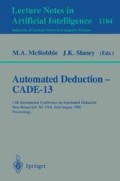Abstract
Many implementations of model elimination perform proof search by iteratively increasing a bound on the total size of the proof. We propose an optimized version of this search mode using a simple divide-and-conquer refinement. Optimized and unoptimized modes are compared, together with depth-bounded and best-first search, over the entire TPTP problem library. The optimized size-bounded mode seems to be the overall winner, but for each strategy there are problems on which it performs best. Some attempt is made to analyze why. We emphasize that our optimization, and other implementation techniques like caching, are rather general: they are not dependent on the details of model elimination, or even that the search is concerned with theorem proving. As such, we believe that this study is a useful complement to research on extending the model elimination calculus.
Preview
Unable to display preview. Download preview PDF.
References
O. L. Astrachan and M. E. Stickel. Caching and lemmaizing in model elimination theorem provers. In D. Kapur, editor, 11th International Conference on Automated Deduction, volume 607 of Lecture Notes in Computer Science, pages 224–238, 1992. Springer-Verlag.
P. Baumgartner and U. Furbach. Model elimination without contrapositives and its application to PTTP. Research report 12-93, Institute for Computer Science, University of Koblenz, 1993.
B. Beckert and J. Posegga. leanT A P: Lean, tableau-based deduction. Journal of Automated Reasoning, 15:339–358, 1995.
M. J. C. Gordon and T. F. Melham. Introduction to HOL: a theorem proving environment for higher order logic. Cambridge University Press, 1993.
R. E. Korf. Depth-first iterative-deepening: An optimal admissible tree search. Artificial Intelligence, 27:97–109, 1985.
R. Letz, J. Schumann, S. Bayerl, and W. Bibel. SETHEO: A high-performance theorem proven. Journal of Automated Reasoning, 8:183–212, 1992.
R. Letz, K. Mayr, and C. Goller. Controlled integrations of the cut rule into connection tableau calculi. Technical Report AR-94-01, TU München, 1994.
V. Lifschitz. Mechanical Theorem Proving in the USSR: the Leningrad School. Monograph Series on Soviet Union. Delphic Associates, 1986. See also ‘What is the inverse method?’ in the Journal of Automated Reasoning, vol. 5, pp. 1–23, 1989.
D. W. Loveland. Mechanical theorem-proving by model elimination. Journal of the ACM, 15:236–251, 1968.
D. Michie. “Memo” functions and machine learning. Nature, 218:19–22, 1968.
L. C. Paulson. Isabelle: a generic theorem prover, volume 828 of Lecture Notes in Computer Science. Springer-Verlag, 1994. With contributions by Tobias Nipkow.
D. A. Plaisted. A sequent-style model elimination strategy and a positive refinement. Journal of Automated Reasoning, 6:389–402, 1990.
P. Rudnicki. Obvious inferences. Journal of Automated Reasoning, 3:383–393, 1987.
M. E. Stickel. A Prolog Technology Theorem Prover: Implementation by an extended Prolog compiler. Journal of Automated Reasoning, 4:353–380, 1988.
C. B. Suttner and G. Sutcliffe. The TPTP problem library. Technical Report AR-95-03, TU München, 1995.
M. Tarver. An examination of the Prolog Technology Theorem-Prover. In M. E. Stickel, editor, 10th International Conference on Automated Deduction, volume 449 of Lecture Notes in Computer Science, pages 322–335, 1990. Springer-Verlag.
P. Weis and X. Leroy. Le langage Caml. InterEditions, 1993. See also the CAML Web page: http://pauillac.inria.fr/caml/.
Author information
Authors and Affiliations
Editor information
Rights and permissions
Copyright information
© 1996 Springer-Verlag Berlin Heidelberg
About this paper
Cite this paper
Harrison, J. (1996). Optimizing proof search in model elimination. In: McRobbie, M.A., Slaney, J.K. (eds) Automated Deduction — Cade-13. CADE 1996. Lecture Notes in Computer Science, vol 1104. Springer, Berlin, Heidelberg. https://doi.org/10.1007/3-540-61511-3_97
Download citation
DOI: https://doi.org/10.1007/3-540-61511-3_97
Published:
Publisher Name: Springer, Berlin, Heidelberg
Print ISBN: 978-3-540-61511-8
Online ISBN: 978-3-540-68687-3
eBook Packages: Springer Book Archive

